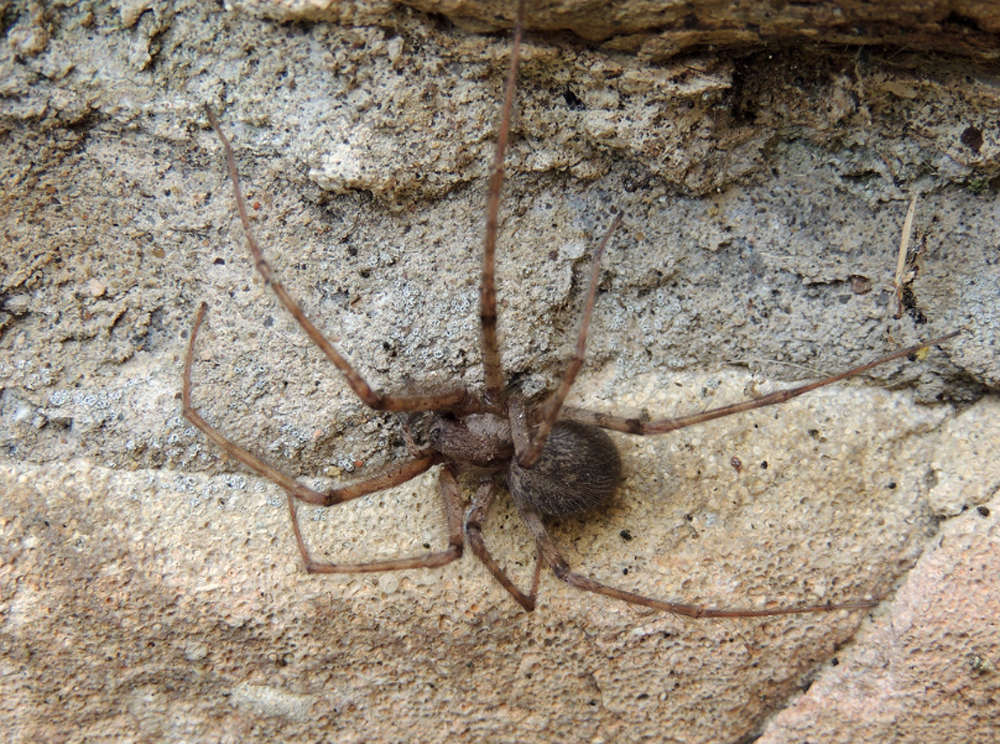In the realm of arachnids, the Cardinal Spider (Tegenaria parietina) holds a special place in the British Isles. Often referred to as the Common House Spider, this species belongs to the Tegenaria genus, which encompasses several spiders frequently encountered in domestic settings. However, the Cardinal Spider stands out from its counterparts due to its remarkable size, unique appearance, and intriguing behavioural patterns. This comprehensive article delves into the various facets of the Cardinal Spider, shedding light on its physical characteristics, habitat preferences, behaviour, life cycle, ecological significance, and the coexistence dynamics between humans and this fascinating creature.
Physical Characteristics
The Cardinal Spider exhibits an impressive size, with females measuring up to 20 millimetres in body length, while males are slightly smaller, averaging around 15 millimetres. The body is adorned with dense hair, giving it a velvety texture. The cephalothorax, which comprises the head and thorax, features a reddish-brown hue, with a darker, almost black central region bordered by lighter-coloured edges. The abdomen is typically yellowish-brown, adorned with distinct dark stripes or chevron-like markings.
A prominent characteristic of the Cardinal Spider is its elongated and slender legs, showcasing bands of alternating dark and light colours. These agile appendages allow the spider to navigate various terrains with remarkable swiftness. The arrangement of the spider’s eyes is another notable feature, with four small eyes in the top row and two larger eyes positioned beneath. This configuration provides the Cardinal Spider with excellent vision, enabling it to detect prey and potential threats in its surroundings.

Habitat and Distribution
The Cardinal Spider enjoys a widespread distribution throughout the British Isles, commonly found in gardens, forests, and, as its name implies, human habitats. It shows a preference for dark, undisturbed areas, such as basements, cellars, and sheds. During the autumn season, male spiders often embark on quests to find mates, which frequently leads to their unexpected appearance in bathtubs, sinks, or other unconventional locations. While primarily nocturnal, the Cardinal Spider may venture out during daylight hours in search of food or when disturbed.
Behaviour and Diet
The Cardinal Spider displays shy and solitary behaviour. It constructs intricate webs that serve as traps for its prey, mainly consisting of insects such as flies, mosquitoes, and moths. These webs are typically constructed in corners, crevices, or along walls, featuring a funnel-shaped retreat at one end. From this retreat, the spider patiently awaits vibrations signalling the presence of trapped prey. Once alerted, it emerges swiftly to immobilise and consume its ensnared victim.
Despite its intimidating appearance, the Cardinal Spider poses minimal threat to humans. It is non-aggressive and typically resorts to biting only when directly threatened or provoked. While its venom is not medically significant, it can cause mild irritation comparable to a bee sting. It is worth noting that, although rare, some individuals may experience allergic reactions to spider bites, warranting medical attention if severe symptoms manifest.
Life Cycle and Reproduction
The life cycle of the Cardinal Spider commences with courtship rituals, during which males engage in elaborate displays to attract females. These displays involve leg drumming, body vibrations, and the release of pheromones to communicate availability and intentions. Upon successful mating, the female produces an egg sac, which she diligently guards and protects until the spiderlings hatch.
The emergence of spiderlings from the egg sac typically occurs in late summer or early autumn. As they grow, they undergo several moults, shedding their exoskeletons to accommodate their increasing size. Cardinal Spiders can live for up to three years, while males have shorter lifespans, often dying shortly after mating.

Ecological Significance
The Cardinal Spider plays a vital role in maintaining the balance of ecosystems. As a natural predator of insects, it aids in controlling populations of pests that may pose threats to crops and human habitats. By preying on insects, the spider contributes to the natural pest control mechanism, reducing the reliance on chemical pesticides.
Moreover, the presence of the Cardinal Spider serves as an indicator of environmental health. Its existence in homes and gardens signifies a thriving ecosystem, as it requires an ample supply of prey. Consequently, conservation efforts aimed at protecting and preserving this species contribute to the overall biodiversity and ecological well-being of the British Isles.
Coexistence with Humans
The Cardinal Spider often instils a mixture of awe and fear among humans. However, it is important to recognise its significant role in natural pest control and ecosystem balance. Rather than resorting to unnecessary eradication measures, fostering a sense of coexistence is crucial. Simple preventive actions, such as sealing cracks and crevices, can reduce the likelihood of spider intrusion into living spaces.
Education about the Cardinal Spider’s non-aggressive nature and ecological importance can help dispel unfounded fears. Additionally, seeking professional help from pest control experts can provide guidance on spider management techniques that prioritise the well-being of both humans and the spiders themselves.
Conclusion
The Cardinal Spider (Tegenaria parietina) stands as an intriguing arachnid within the UK, distinguished by its size, appearance, behaviour, and ecological significance. Understanding and appreciating the unique attributes of this species contributes to the conservation of biodiversity and the delicate balance of ecosystems. By adopting a harmonious coexistence approach, humans can ensure the mutual well-being of both themselves and the captivating Cardinal Spider.
Sources and References
- Roberts, M. J. (1996). Collins Field Guide: Spiders of Britain and Northern Europe. Collins.
- Harvey, P., & Nellist, D. (2017). Britain’s Spiders: A Field Guide (2nd ed.). Princeton University Press.
Sam loves to learn about animals and their habitats. He has been a nature lover from a very young age, and has been writing papers and articles about wildlife for as long as he can remember.

Crafty they are yet dumb; I have seen at least 10, 1 in a cup – it trapped it self for me. Another I “removed”
and 1 more in my room yet to be “removed.” Tips for removal… put your light on it will hide!